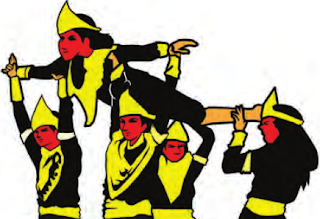Indonesia has a rich diversity of dance that is different between tribes. Of course we can see the characteristics of each ethnic dance different from each other. For instance motion on Malay and Sundanese dance performed always coincide with the beat (on the beat) with power being. Javanese dance tends to be done in slow motion and force are. Balinese dance performed by the energy and time varying motion. These differences are caused by the energy released, space, and time varying movement between each dance.
 |
| Fig 1. Motion with strong force element |
Power used by dancers to support his friend certainly greater than the force raised dancer. Manpower strength to withstand heavy loads concentrated on his hands. Similarly, in every exercise, of course, takes power. Use in power have a strong intensity, moderate and weak depending on how the use or distribution of such power.
 |
| Fig 2. Pose gestures wide open |
Consider dance shown in Figure 2. Pose motion showed broad visible space between the body and arms are done in groups of dancers. All the dancers perform the same space. Motion in space can be done alone, in pairs or groups. In addition to requiring power and space, the motion also requires time. Any movement takes time. Differences fast or slow motion associated with the tempo. So tempo is: fast or slow motion carried.
 |
| Fig 3. Motion Respect |
No comments:
Post a Comment